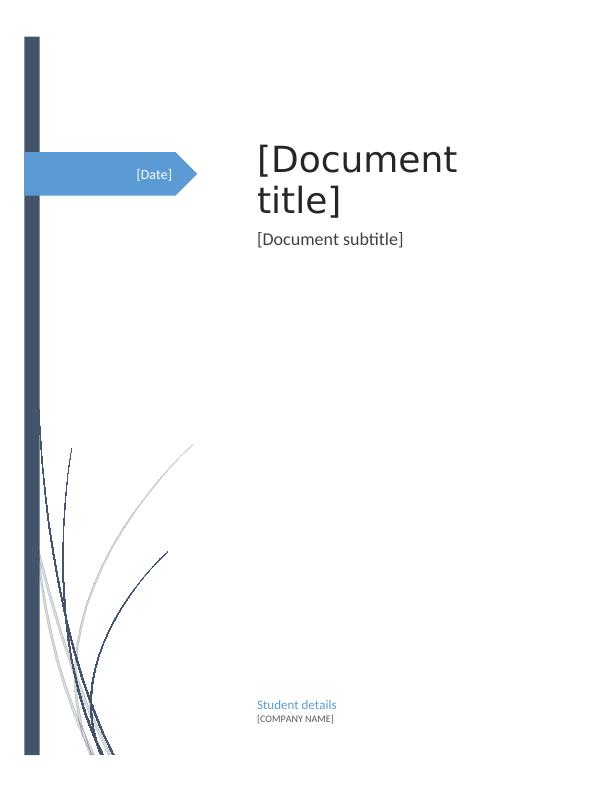ICT700 Systems Analysis and Design
15 Pages3023 Words113 Views
university of sunshine coast
System Analysis and Design (ICT700)
Added on 2020-05-11
ICT700 Systems Analysis and Design
university of sunshine coast
System Analysis and Design (ICT700)
Added on 2020-05-11
ShareRelated Documents
[Date]Student details[COMPANY NAME][Document title][Document subtitle]

Contents1 Adaptive methodologies...........................................................................................................................21.1Scrum...........................................................................................................................................31.1.1Advantages of scrum...........................................................................................................31.1.2Disadvantages of scrum.......................................................................................................41.2Extreme programming (XP).........................................................................................................41.2.1Advantages of Extreme programming.................................................................................51.2.2Disadvantages of Extreme programming.............................................................................51.3Unified process (UP)....................................................................................................................51.3.1Advantages of UP.................................................................................................................61.3.2Disadvantages of UP............................................................................................................62Recommendation................................................................................................................................63Event table...........................................................................................................................................74Model class diagram............................................................................................................................85Design class diagram............................................................................................................................96Use diagram.......................................................................................................................................107Use case description..........................................................................................................................10Human Computer Interaction...................................................................................................................12References.................................................................................................................................................14

1 Adaptive methodologiesAdaptive methodologies are methodologies that were introduced to replace or compliment the traditional predictive approaches like the dominant waterfall model for software development. The main concept embraced by adaptive methodologies is that the software development life cycle is a highly dynamic process and the activities undertaken during the software development life cycle have tobe adjusted as the on various stages and phases of the project. Adaptive methodologies are effective because at most times the project is not well understood at the initial stages thus requirements are bound to change as the project progresses onwards. A good example of how adaptive methodologies work is the spiral model which makes continuous cycles through the development activities until the project is over. The main focus of adaptive methodologies are results where by the results are features of the system which are delivered to the client in increments. Thus adaptive methodologies are iterative.The basic adaptive methodology life cycle has four stages;Project initiationAdaptive cycle planningConcurrent feature developmentQuality reviewFinal question and answer and release.Figure 1: Adaptive methodologies life cycle phasesFigure 1 shows the life cycle of adaptive methodologies. Project initiation involves identifying and defining the objectives and the mission of the project by understanding the constraints under which the project should be developed, establishing the organization of the project, identifying and defining the requirements, identifying the size and the scope of the project and finally identifying all the key possible project risks that could occur during the development process. The other steps involve developing and defining iterations that will be followed to deliver feature oriented increments to the clients.There are various adaptive methodology approaches but this report will focus only on 3 approaches;ScrumExtreme programming(UP)

Unified process approach(UP)1.1ScrumScrum is an agile process of software development methodology or framework that adopts the agile software development approach of developing the software. It follows and adapts to all the values and principles of adaptive methodology but includes more specific definitions and specifications on how the project should be developed(Adel, 2011). Scrum makes information about a project transparent to the users thus addresses the complexity that may arise from the various phases of the development life cycle. This further makes it easy for the development team to adapt on the constantly changing requirements which were not foreseen during the initial project definition stage (Faucheux, 2012). The stages of scrum methodology are;PlanningStaging the developmentRelease.The planning and tagging development stages are stages where all the functional development of the project is carried out in iterations by creating sprints which can be identified as features of the products. The sprints are allocated to the development team and are delivered within a specified timeframe usually two to four weeks. The basic practices of scrum are;Iterations- In scrum, all the work is done in iterations which usually last two to four weeks. After completion of a sprint, thorough inspection is done on each sprint to make sure that the project does not proceed in the wrong direction because of a fault in a sprint.Increments- In scrum, an increment is a fully working feature of the system which is achieved after completion of a sprint. This increment has to be inspected to make sure that it complete and works correctly.Emergence- complexity in projects emerge in many unpredictable ways as the project is being developed. It’s not possible to always predict how such complexities end but scrum makes it easy to anticipate these complexities by making it easy for the project to incorporate changes in requirements even at the late stages of the development.Self-organization- Personnel can be one of the most unpredictable factors in software development so it’s necessary to develop a plan to deal with these kind of uncertainties. This is done by enabling the development team to manage their work by relying on their experience from past projects. This can be enhanced by use of other approaches like use of object modelingtechniques like PERT charts.Collaboration- Scrum works if the all the stakeholders collaborate and communicate freely and openly. All stakeholders are encouraged to contribute to the project not based on the roles assigned to them but based on their capabilities.Scrum methodology is typically used for complex projects whose scope is not well defined and thereare expectations of changes in the requirements as the project development goes on.1.1.1Advantages of scrumThe following are the advantages of scrum;

End of preview
Want to access all the pages? Upload your documents or become a member.
Related Documents
ICT700 : System Analysis And Designlg...
|14
|2699
|109
ICT310 System Analysis and Design - Assignmentlg...
|9
|1322
|149
CSI 3370 Software Process and Project Management.lg...
|15
|3004
|10
Adaptive Software Development Methodologies and Design Approaches for Online Book Ordering Systemlg...
|18
|3100
|368
System Development Methodology - Assignmentlg...
|10
|1554
|121
Agile and Iterative systems developmentlg...
|13
|2483
|364
